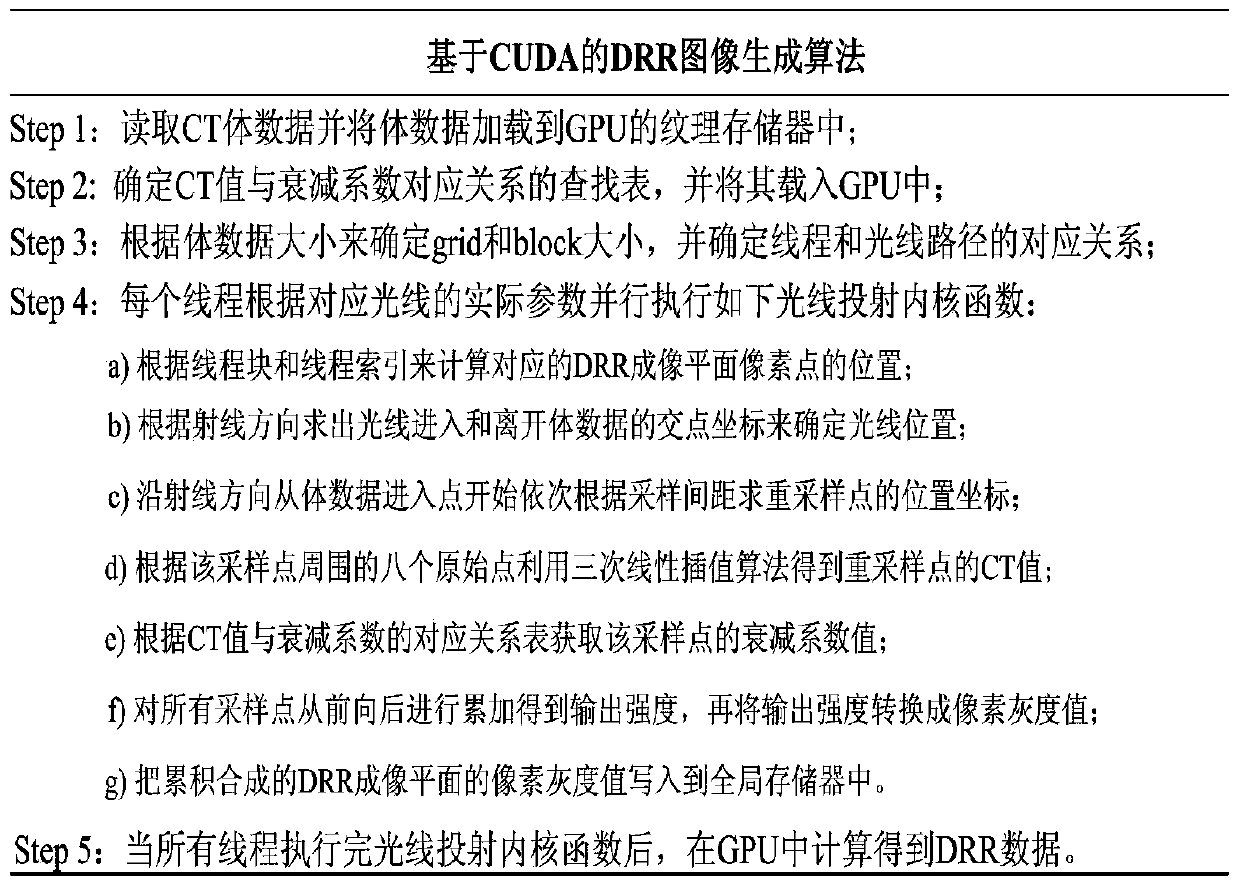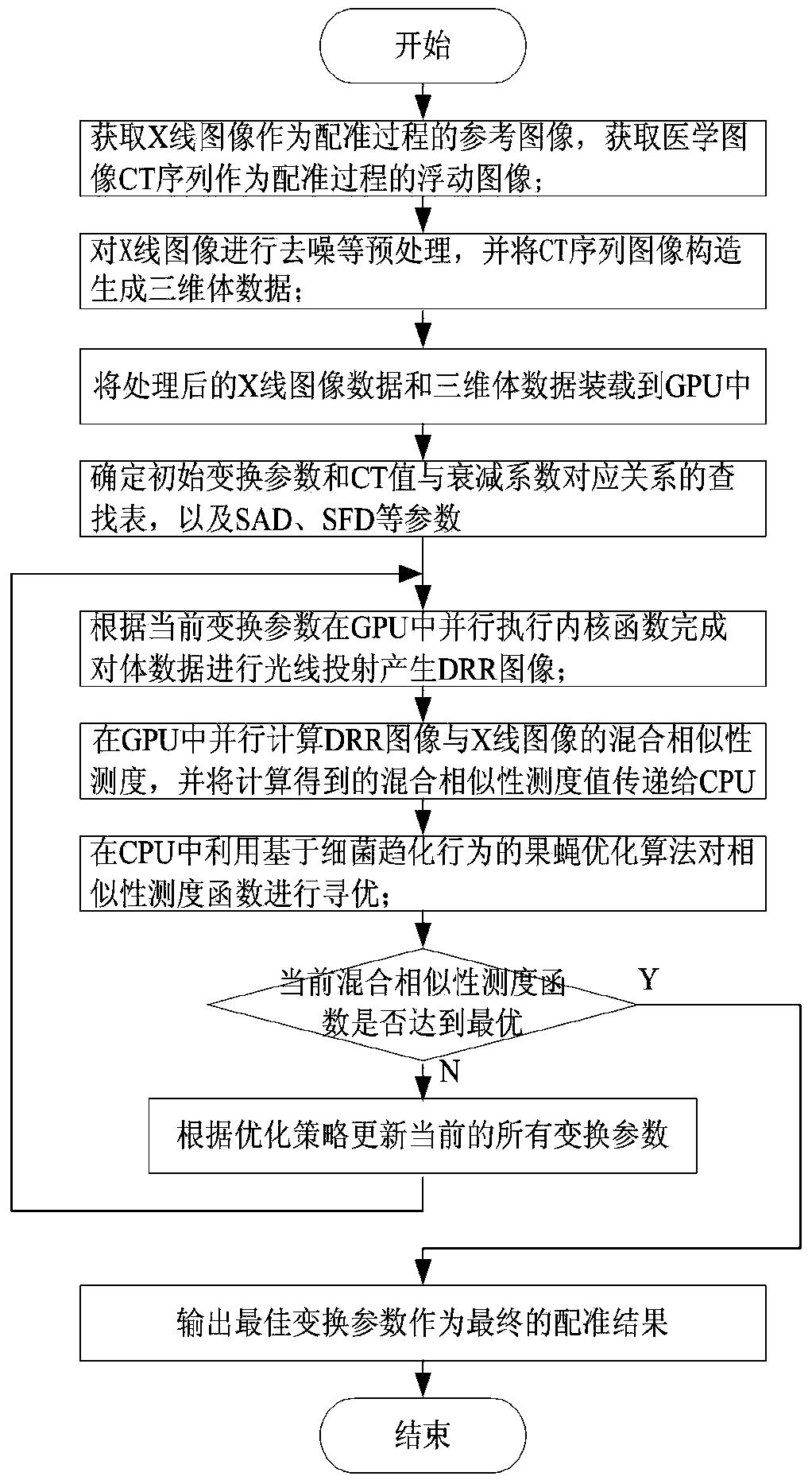2D-3D medical image parallel registration method based on combination similarity measure
A similarity measurement, 2D-3D technology, applied in image analysis, image data processing, instruments, etc., can solve problems that cannot meet the real-time requirements of image-guided radiotherapy, affect the efficiency of 2D-3D registration algorithms, and achieve global search Excellent ability, easy to calculate the effect
- Summary
- Abstract
- Description
- Claims
- Application Information
AI Technical Summary
Problems solved by technology
Method used
Image
Examples
Embodiment 1
[0051] CUDA is a development environment and software architecture that can use C-like language for general computing without the help of graphics API. Improve the execution efficiency of the algorithm. In the DRR generation algorithm based on ray casting, each beam of light penetrates volume data to simulate the attenuation process of X-rays after entering the human body, which is independent of each other and has good parallelism. Therefore, the process can be realized by designing a kernel function executed on the GPU. accomplish.
[0052] Since the input data for generating DRR is a medical CT image sequence, its resolution is usually 512*512, and the resolution of DRR that needs to be used in the 2D-3D registration process is also 512*512, so 512*512 can be emitted from the light source 512 rays, each corresponding to a pixel of the DRR image, the process of sampling a ray through the volume data and accumulating the calculation of the CT value is encapsulated in the ker...
Embodiment 2
[0076] Medical image registration is essentially a process of seeking the optimal solution using the similarity measure function as the objective function. Since many similarity measurement functions have multiple local extremums, an intelligent optimization algorithm with a strong global optimization ability is used in the medical image registration process, which is helpful for finding the global optimal value and improving the accuracy of registration results. Significance.
[0077] Fruit Fly Algorithm (FOA) is a global optimization algorithm that simulates the foraging behavior of fruit flies proposed by Professor Pan Wenchao, a Taiwanese scholar. This algorithm has the characteristics of few parameters, short running time, easy understanding and implementation, etc., and is widely used. It is used in many fields of science and engineering. However, when optimizing the similarity measure function with multi-extreme features in medical image registration, FOA, like genetic...
Embodiment 3
[0097] In order to evaluate the execution efficiency and registration accuracy of the 2D-3D registration algorithm of the present invention, the present invention collects multiple groups of clinical radiotherapy X-ray images and CT image sequences used to formulate radiotherapy plans for different patients as the original data of this experiment. In the quasi-experiment, the X-ray image is used as a reference image, and the CT image sequence used for radiotherapy planning is used as a floating image. The DRR image is generated by performing a 6-degree-of-freedom rigid transformation on the CT image sequence, and the mixed similarity of the X-ray image and the DRR image is calculated. Measure and use the fruit fly optimization algorithm for global optimization, so as to realize the whole registration process. Since the two steps of DRR generation process and mixed similarity measure function calculation in the 2D-3D medical image registration algorithm of the present invention ...
PUM
 Login to View More
Login to View More Abstract
Description
Claims
Application Information
 Login to View More
Login to View More - R&D
- Intellectual Property
- Life Sciences
- Materials
- Tech Scout
- Unparalleled Data Quality
- Higher Quality Content
- 60% Fewer Hallucinations
Browse by: Latest US Patents, China's latest patents, Technical Efficacy Thesaurus, Application Domain, Technology Topic, Popular Technical Reports.
© 2025 PatSnap. All rights reserved.Legal|Privacy policy|Modern Slavery Act Transparency Statement|Sitemap|About US| Contact US: help@patsnap.com



